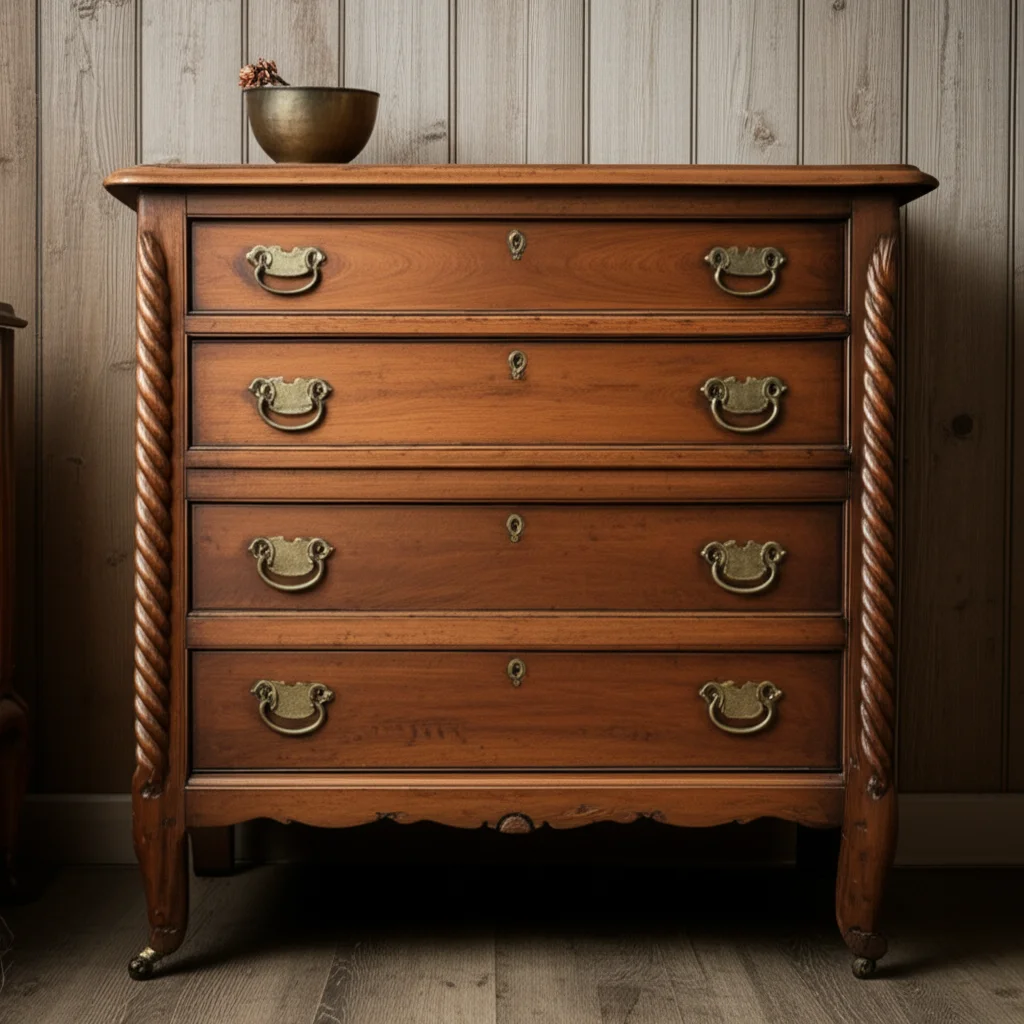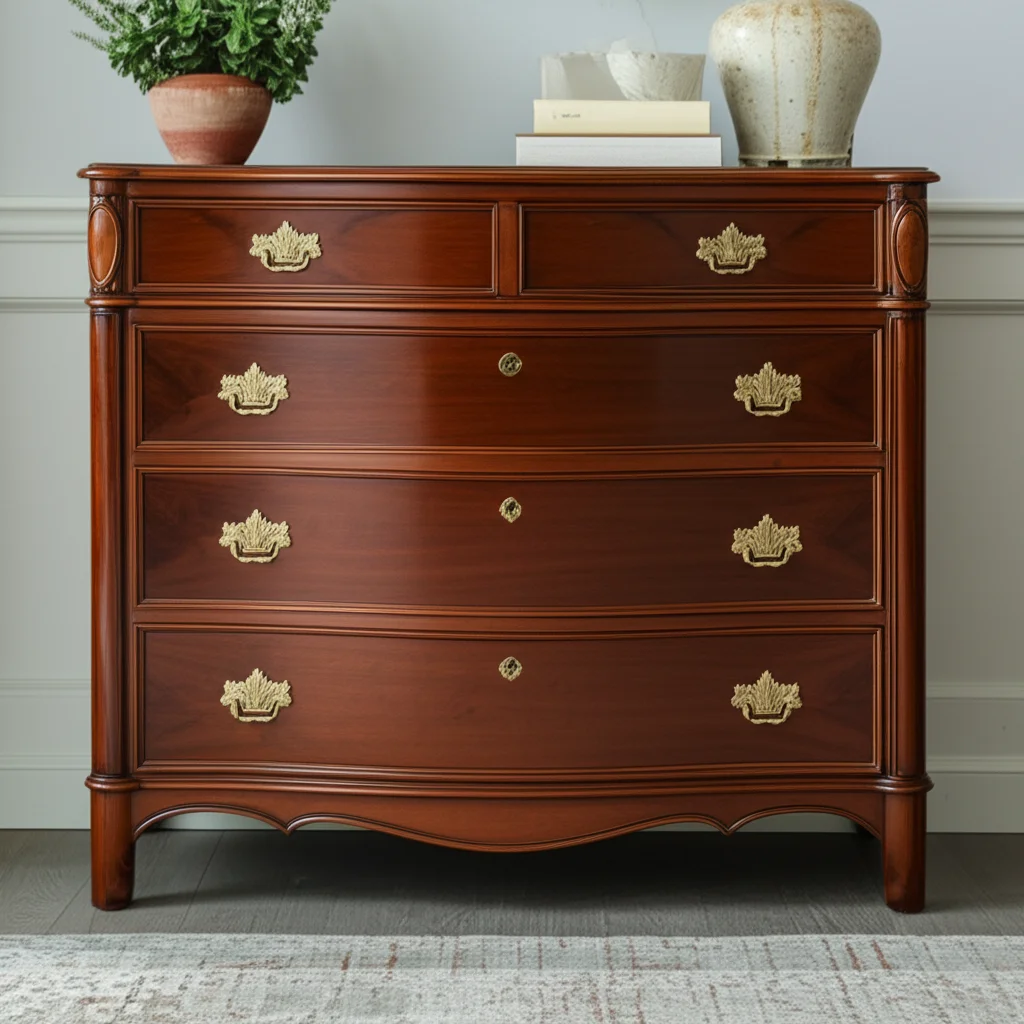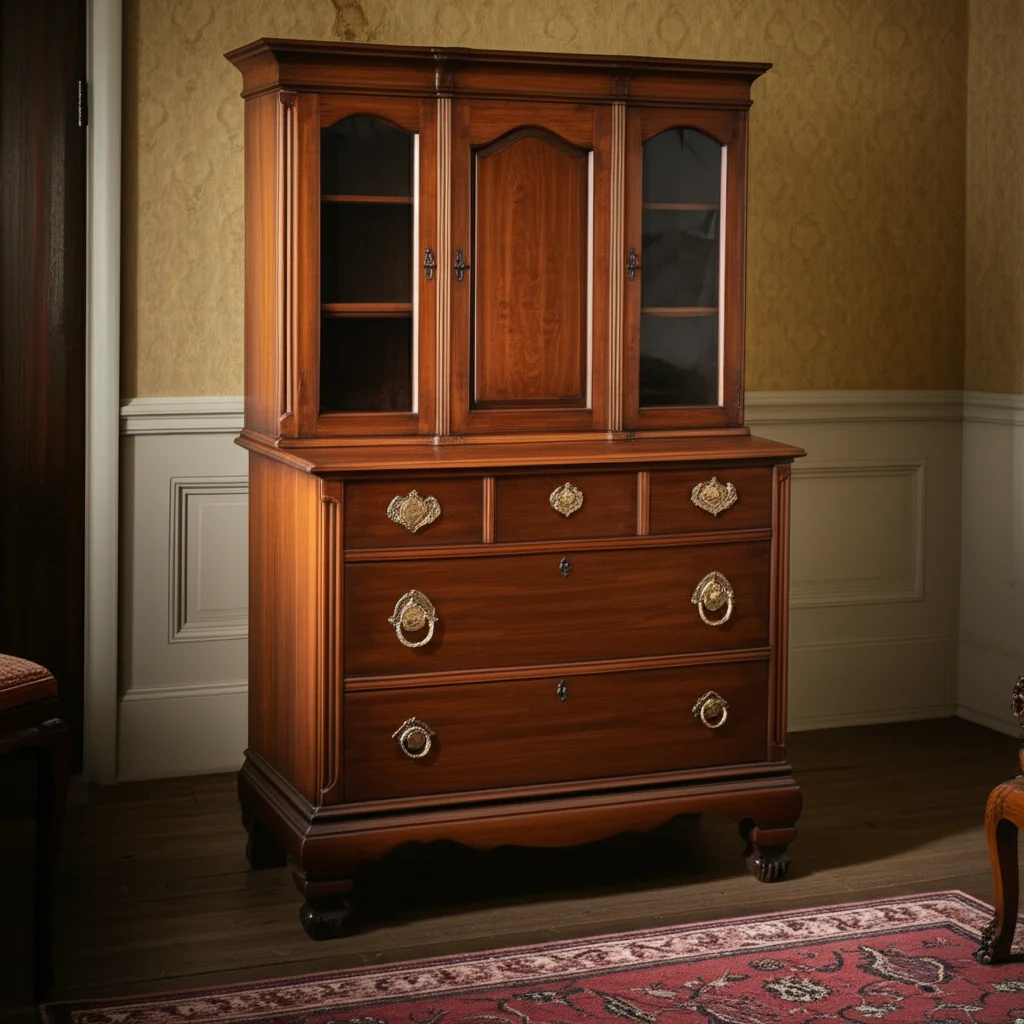· Todd Martin · Antique Furniture · 13 min read
How To Date Barley Twist Furniture

Unlock the Secrets: How to Date Barley Twist Furniture
Have you ever looked at a beautiful piece of furniture with its distinctive spiral legs and wondered how old it truly is? Dating barley twist furniture can feel like a puzzle. This unique style, characterized by its corkscrew or helix-shaped turning, holds clues to its past. Understanding these clues helps you appreciate the craftsmanship and historical significance of your piece. We are going to explore the different ways to pinpoint the age of your barley twist furniture.
This article will guide you through the key indicators. We will discuss the historical periods when barley twist was popular. You will learn about different wood types, construction techniques, and hardware. We will also cover finishes, upholstery, and how to spot telltale signs of authenticity. By the end, you will have the knowledge to confidently assess the age of your cherished barley twist pieces.
Takeaway
- Examine the wood type and finish for clues.
- Look closely at construction methods, like joinery.
- Assess hardware and upholstery for period-specific details.
- Understand the historical popularity of barley twist.
- Research maker’s marks and provenance when possible.
What is the most effective way to date barley twist furniture?
The most effective way to date barley twist furniture involves a comprehensive examination of its construction, materials, and stylistic details. Look for specific wood types, hand-cut joinery, original hardware, and historical design elements. These features combine to accurately place a piece within its likely period of creation, often between the mid-19th and early 20th centuries.
Understanding the History of Barley Twist Furniture
Barley twist is a decorative element featuring a spiraling, twisted form. It appears most often on legs, columns, and stretchers of furniture pieces. This distinctive style first appeared in Europe during the 17th century, influenced by Jacobean design. However, its major resurgence happened much later, in the 19th century. This Victorian-era revival saw barley twist become a highly popular design motif.
The popularity of barley twist furniture peaked during the late Victorian and Edwardian periods. This spans roughly from the 1880s through the early 1900s. Advances in woodworking machinery made this intricate turning more accessible and less labor-intensive. This allowed manufacturers to produce barley twist pieces in greater numbers. As a result, many antique barley twist items you encounter today date from these specific decades.
While often associated with the British Arts and Crafts movement, barley twist also found its way into other design styles. Its robust and decorative nature suited the Victorian aesthetic of ornamentation. Understanding these historical waves helps in dating. Earlier pieces from the 17th century are rare and show hand-turned imperfections. Later pieces from the 19th and 20th centuries are more common and show machine precision. Knowing this broad timeline provides a crucial first step in dating your piece.
Inspecting Wood Type and Grain Patterns
The type of wood used is a major indicator when dating barley twist furniture. Different woods were popular during different eras. English oak was a primary choice for early Jacobean revival pieces. This heavy, durable wood offers a rich, deep grain. Its use signifies a sturdy, often rustic appeal.
As time progressed into the late Victorian period, mahogany became highly favored. Mahogany offers a finer grain and a darker, often reddish-brown hue. It allows for more refined finishes. Walnut was another popular choice, known for its elegant grain and warm tones. These woods were often used for dining tables, chairs, and sideboards. Learning to identify wood in antique furniture is a very useful skill for dating.
Beyond the specific wood species, examine the grain pattern and how it interacts with the twist. On true antique barley twist, the grain of the wood follows the twist. This means the wood was turned while twisting. Reproductions might simply carve a twist onto a straight piece of wood. This carving method results in a grain that runs straight up and down, not spiraling with the twist. This small detail is a critical differentiator for genuine barley twist furniture. Additionally, look at how the wood has aged. Old wood will have a distinct patination and often show a deeper, richer color than newer wood.
Examining Construction Methods and Joinery
The way a piece of barley twist furniture is put together offers significant clues about its age. Before the mid-19th century, furniture makers relied heavily on hand tools and traditional joinery. This included techniques like dovetail joints, mortise and tenon joints, and pegged construction. These joints often show slight irregularities or tool marks, which are signs of hand craftsmanship. Each joint was cut and fitted individually.
As industrialization advanced in the late 19th century, machine-cut joinery became common. Dovetails might appear perfectly uniform. Screws and glue became more prevalent for assembly. While screws were used in earlier periods, the type of screw (e.g., flathead versus Phillips head) and their prevalence can indicate age. Phillips head screws, for example, were not widely used until the 20th century. Look for signs of older, possibly square-headed nails or wooden pegs that secure joints.
Pay close attention to how the barley twist components connect to the rest of the furniture. Are they seamlessly integrated, or do they appear to be added on? On authentic older pieces, the barley twist elements are usually integral to the structural design. They are not merely decorative overlays. Strong, well-executed joinery suggests a piece designed for durability, typical of fine antique furniture. For a general understanding of furniture construction, compare it with how other antique pieces are made, such as learning how to date a gate-leg table. This can help you identify characteristics shared across different antique furniture types.
Hardware, Finishes, and Upholstery Clues
The hardware on your barley twist furniture can be a strong age indicator. Original hardware, like drawer pulls, hinges, and escutcheons, often reflects the style of its period. For instance, many Victorian barley twist pieces might feature brass pulls or ornate cast-iron elements. Look for signs of wear and patination on the metal. Old hardware will often show a natural darkening and sometimes greening (verdigris) in recessed areas. Modern reproductions might use new, shiny hardware that looks out of place. Examine how the hardware is attached. Screws that appear too new or different from the surrounding ones might indicate replacement. For tips on maintaining these vital elements, consider how to clean hardware on old furniture.
Finishes also offer insight. Older pieces usually have shellac or varnish finishes. These tend to darken and craze (develop fine cracks) over time. This natural aging process creates a deep, rich patina. Newer pieces or reproductions might have polyurethane or lacquer finishes, which look more uniform and less aged. Also, observe how the finish has worn. Natural wear patterns, especially on edges and high-touch areas, suggest genuine age. An evenly applied, too-perfect finish might point to a recent refinishing or a newer piece.
If your barley twist furniture includes upholstery, this offers another set of clues. Original upholstery fabric and its stuffing materials (horsehair, straw, kapok) are period-specific. Victorian upholstery often features rich velvets, brocades, or needlepoint. The springs, if present, also provide clues. Coil springs, for example, became common in the mid-19th century. If the upholstery looks brand new, it is likely a replacement, which can complicate dating. However, even if replaced, remnants of the original fabric or stuffing might be found underneath, providing valuable information.
Identifying Eras: Victorian to Edwardian Styles
Barley twist furniture saw its most significant resurgence during the Victorian and Edwardian periods. Understanding the subtle differences between these eras helps in accurate dating.
Victorian Barley Twist (circa 1880-1901)
Victorian barley twist pieces often showcase a heavier, more ornate aesthetic. They typically feature robust and richly turned spirals. Common woods include dark oak, mahogany, and sometimes walnut. Finishes are usually dark, contributing to a sense of gravitas. You might find additional decorative elements like carvings or applied mouldings. Chairs, sideboards, and dining tables are common forms. The overall design often leans into the “more is more” philosophy characteristic of the era. The twist itself can be quite pronounced and chunky.
Edwardian Barley Twist (circa 1901-1910)
As the Edwardian era dawned, tastes began to shift. Barley twist furniture from this period often exhibits a slightly lighter, more refined feel. While still substantial, the twists might be less overtly massive. There is a move towards simpler lines and a greater emphasis on the beauty of the wood grain. Oak remained popular, but lighter stains or finishes sometimes appeared. Mahogany continued to be used for more formal pieces. Dining sets and parlor chairs are common examples. The Edwardian period often blended Victorian grandeur with emerging Arts and Crafts influences. This resulted in a transitional style. Knowing these nuances helps you distinguish between pieces from different decades.
Maker’s Marks and Provenance: Researching Your Piece
Finding a maker’s mark or label is the most definitive way to date barley twist furniture. Many furniture manufacturers, especially from the late 19th and early 20th centuries, proudly marked their work. These marks can be impressed into the wood, stenciled, or applied as paper labels. Look on the underside of tables, the back of chests, inside drawers, or on the frames of chairs. The mark might include the company name, a patent number, or even a date. If you find a mark, research the company. This will usually provide a clear production timeline for that specific manufacturer.
Provenance, or the documented history of ownership, is another powerful tool. If you have any records, such as old purchase receipts, family inventories, or photographs, these can confirm the age and origin of your piece. While less common, a strong provenance significantly increases the value and authenticity of antique furniture. Always ask the seller for any known history if you are purchasing a piece. This information provides context and helps to corroborate other dating clues.
Even without official marks or detailed provenance, research similar pieces. Online antique databases, auction house records, and specialized furniture history books can show comparable items. Seeing what experts attribute to certain periods helps train your eye. You might find similar designs, construction features, or wood choices. This comparative analysis strengthens your dating assessment. Just as one might research how to date Berkey and Gay furniture by their specific marks and styles, apply the same systematic approach to your barley twist piece.
Distinguishing Authentic Barley Twist from Replicas
Identifying a true antique barley twist furniture piece versus a modern reproduction requires a keen eye. Many reproductions were made in the mid-20th century, particularly during periods of revival. Later replicas might try to mimic the aged look.
One key difference often lies in the precision of the twist. Antique pieces, especially those made before mass industrialization, may show slight irregularities. These small imperfections are from the hand-turning process. The twists might not be perfectly uniform from one leg to another. Later machine-made antique pieces (late Victorian/Edwardian) will be more uniform, but still exhibit natural wood aging. Modern reproductions might have overly perfect, uniform twists, sometimes carved rather than turned with the grain. Remember, the grain on true turned barley twist will follow the spiral, not run straight. This is one of the best ways to tell if furniture is real wood and if the twist is authentic.
Examine the finish and patina. As discussed, true antiques have a natural, aged finish that takes decades to develop. This includes darkening, minor crazing, and gentle wear on edges. Reproductions often use finishes that try to mimic this. However, they lack the depth and natural feel of a true patina. They might also appear too glossy or too evenly distressed. Look for consistent wear in areas that would naturally be handled. An overall “distressed” look that seems artificial suggests a newer piece.
Finally, consider the weight and overall feel. Antique furniture, especially pieces from the Victorian era, often feels substantial and solid. They used denser woods and robust construction. Reproductions can sometimes feel lighter or less sturdy. Pay attention to all these details. A combination of factors, not just one, usually confirms authenticity. If a price seems too good to be true for a purported antique, it might be a reproduction.
Care and Preservation of Your Barley Twist Furniture
Once you have dated your barley twist furniture, proper care becomes important. Antique pieces need careful handling to preserve their condition and value. Regular dusting with a soft cloth helps prevent dust buildup. Use a dry cloth to avoid moisture damage. When cleaning, avoid harsh chemicals or abrasive cleaners. These can strip the original finish and damage the wood. For general care, you can use a damp cloth followed by a dry one. For a deeper clean, consider using products specifically designed for antique wood. Learning how to clean wooden furniture correctly is important.
Protect your furniture from direct sunlight, extreme temperatures, and humidity fluctuations. These conditions can cause wood to warp, crack, or fade. Place your furniture away from windows, radiators, and air conditioning vents. Use coasters under drinks and placemats under hot dishes to prevent marks. If your piece has a delicate finish, consider applying a good quality furniture wax occasionally. This provides a protective layer and enhances the wood’s natural luster.
Small repairs should be handled by a professional antique restorer. Attempting major repairs or refinishing yourself without expertise can significantly reduce the piece’s value. A restorer can match the original finish and use appropriate techniques to maintain its integrity. Regular, gentle maintenance will ensure your barley twist furniture remains beautiful for generations.
Frequently Asked Questions
What era is barley twist furniture from?
Barley twist furniture first appeared in the 17th century during the Jacobean era. However, its widespread popularity and most common production occurred much later. The peak period for barley twist furniture was from the late Victorian period, around the 1880s, through the Edwardian era, ending in the early 1910s.
How can I tell if my barley twist is an antique?
To identify an antique, examine the wood type, such as oak or mahogany. Look for hand-cut joinery like dovetails with slight irregularities. Original, aged hardware shows natural patination and wear. The wood grain on the twist should follow the spiral, indicating it was turned, not carved.
Is barley twist furniture valuable?
The value of barley twist furniture varies greatly. Factors include its age, condition, rarity, wood type, and craftsmanship. Pieces from known manufacturers or with unique designs tend to be more valuable. A well-preserved original antique will generally fetch a higher price than a reproduction or a heavily damaged piece.
What wood is commonly used for barley twist?
The most common woods used for barley twist furniture during its peak popularity were oak, mahogany, and walnut. Oak was often favored for its durability and rustic appeal, particularly in Arts and Crafts influenced pieces. Mahogany and walnut provided a finer grain and darker appearance for more formal furniture.
How do I care for antique barley twist furniture?
Caring for antique barley twist furniture involves regular, gentle dusting with a soft cloth. Avoid harsh chemical cleaners that can damage the original finish. Protect the piece from direct sunlight, extreme temperatures, and humidity fluctuations to prevent warping or cracking. Seek professional help for major repairs or refinishing.
Conclusion
Dating barley twist furniture is a rewarding process that connects you to history. We have explored the key elements for accurate dating. You should now feel more confident in examining wood types, scrutinizing construction methods, and assessing hardware and finishes. Remember, a combination of these factors paints the most accurate picture.
By understanding the historical context and specific design cues, you can better appreciate the artistry of your piece. Whether you own a Victorian sideboard or an Edwardian chair, its unique twisted form tells a story. This knowledge helps you preserve your furniture and understand its place in history. Keep exploring the fascinating world of antique furniture; each piece holds a secret waiting to be discovered.
- barley twist furniture
- antique furniture
- furniture dating
- Victorian furniture
- Edwardian furniture
- furniture identification
- wood types





